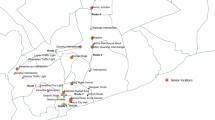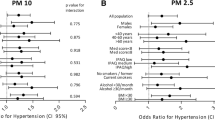Abstract
Kathmandu Valley, Nepal, has severe air pollution, although few studies examine air pollution and health in this region. To the best of our knowledge, no previous studies in Nepal used time-activity diaries or conducted personal monitoring of individuals’ exposures. We investigated personal exposure of particulate matter (PM) with aerodynamic diameter ≤2.5 μm (PM2.5) by location, occupation, and proximity to roadways. PM2.5 monitoring, time-activity diary, respiratory health questionnaire, and spirometer testing were performed from 28 June 2009 to 7 August 2009 for 36 subjects, including traffic police (TP), indoor officer workers next to main road (IOWs_NMR) and away from main road (IOWs_AMR), in urban area (UA), urban residential area, and semi-UA (SUA). TP had the highest exposure of all the occupations (average 51.2 μg/m3, hourly maximum >500 μg/m3). TP levels were higher at the UA than other locations. IOW_NMR levels (averaged 46.9 μg/m3) were higher than those of IOW_AMR (26.2 μg/m3). Exposure was generally higher during morning rush hours (0800–1100 hours) than evening rush hours (1500–1800 hours) for all occupations and areas (78% of days for TP and 84% for urban IOW). PM2.5 personal exposures for each occupation at each location exceeded the World Health Organization ambient PM2.5 guideline (25 μg/m3). Findings suggest potential substantial health impacts of air pollution on this region, especially for TP.
This is a preview of subscription content, access via your institution
Access options
Subscribe to this journal
Receive 6 print issues and online access
$259.00 per year
only $43.17 per issue
Buy this article
- Purchase on Springer Link
- Instant access to full article PDF
Prices may be subject to local taxes which are calculated during checkout


Similar content being viewed by others
References
Bell M.L., Samet J.M., and Dominici F. Time-series studies of particulate matter. Annual Rev Public Health 2004: 25: 247–280.
Pope C.A., and Dockery D.W. Health effect of fine particulate air pollution: lines that connect. J Air Waste Manag Assoc 2006: 55: 709–742.
Cohen A.J., Anderson H.R., Ostro B., Pandey K.D., Krzyzanowski M., and Kunzli N., et al. The global burden of disease due to outdoor air pollution. J Toxicol Environ Health 2005: 68: 301–1307.
Han X., and Naeher L.P. A review of traffic-related air pollution exposure assessment studies in the developing world. Environ Int 2006: 32: 106–120.
Cohen D.D., Garton D., Stelcer E., Wang T., Poon S., and Kim J., et al. Characterization of PM2.5 and PM10 fine particle pollution in several Asian regions, 2002, 16th Int. Clean Air Conf. Christchurch, NZ, 18–22 Aug 02.
Wang G., Wang H., Yu Y., Gao S., Feng J., and Gao S., et al. Chemical characterization of water-soluble components of PM10 and PM25 atmospheric aerosols in five locations of Nanjing, China. Atmos Environ 2003: 37: 2893–2902.
Kawachi I., and Berkman L.F . Neighborhoods and Health. Oxford University Press, New York, 2003.
Bell M.L., Davis D., Cifuentes L., Cohen A., Gouveia N., and Grant L., et al. International expert workshop on the analysis of the economic and public health impacts of air pollution. Environ Health Perspect 2002: 110: 1163–1168.
O’Neill M.S., Jerrett M., Kawachi I., Levy J.I., Cohen A.J., and Gouveia N., et al. Health, wealth, and air pollution: advancing theory and methods. Environ Health Perspect 2003: 111: 1861–1870.
International Center for Integrated Mountain Development (ICIMOD), Ministry of Environment, Science and Technology (MoPE), United Nation Environment Programme (UNEP). Kathmandu valley Environment Outlook. Hill Side Press, Kathmandu, 2007.
Asian Development Bank, Clean Air Initiative for Asian Countries, Country synthesis report on urban air quality management. Phillipines: 2006.
Aryal R.K., Lee B.K., Karki R., Gurung A., Kandasamy J., and Pathak B.K., et al. Seasonal PM10 dynamics in Kathmandu Valley. Atmos Environ 2008: 42: 8623–8633.
Aryal RK, Lee BK, Karki R, Gurung A, Baral B, and Byeon SH Dynamics of PM2.5 concentration in Kathmandu Valley, Nepal. J Hazardous Mater 2009: 168: 732–738.
Giri D., Murthy K., Adhikary P.R., and Khanal S.N. Ambient air quality of Kathmandu Valley as reflected by atmospheric particulate matter concentration (PM10). Int J Environ Sci Tech 2006: 4: 403–410.
Panday A.K., and Prinn R.G. Diurnal cycle of air pollution in the Kathmandu valley, Nepal: observations. J Geophys Res D Atmos 2009: 114: doi: 10.1029/2008JD009777.
Kurmi O.P., Semple S., Steiner M., Henderson G.D., and Ayres J.G. Particulate matter exposure during domestic work in Nepal. Ann Occup Hyg 2008: 52: 509–517.
Joshi S.K., and Dudani I. Environment health effects of brick kilns in Kathmandu valley. Kathmandu Med J 2008: 6: 3–11.
Bashyal A., Majumder A.K., and Khanal S.N. Quantification of PM10 concentration in occupational environment of traffic police personnel in Pokhara sub-metropolitan city, Nepal. Kathmandu University J Sci, Engineering Technol 2008: 5: 73–80.
Ingle S.T., Pachpande B.G., Wagh N.D., Patel V.S., and Attarde S.B. Exposure to vehicular pollution and respiratory impairment of traffic policemen in Jalgaon City, India. Ind Health 2005: 43: 656–662.
Karita K., Yano E., Tamura K., and Jinsart W. Effects of working and residential location areas on air pollution related respiratory symptoms in policemen and their wives in Bangkok, Thailand. Eur J Public Health 2004: 14: 24–26.
Singh V., Sharma B.B., Yadav R., and Meena P. Respiratory morbidity attributed to auto-exhaust pollution in traffic policemen of Jaipur, India. J Asthma 2009: 46: 118–121.
Tamura K., Jinsart W., Yano E., Karita K., and Boudoung D. Particulate air pollution and chronic respiratory symptoms among traffic policemen in Bangkok. Arch Environ Health 2003: 58: 201–207.
Wongsurakiat P., Nana A., Aksornint M., Khun N.M., Naruman C., and Chalermsanyakorn T. Respiratory symptoms and pulmonary function of traffic policemen in Thonburi. J Med Assos Thail Suppl 1999: 82: 435–443.
Chakrabarti B., Fine P.M., Delfino R., and Sioutas C. Performance evaluation of the active-flow personal DataRAM PM2.5 mass monitor (Thermo Anderson pDR-1200) designed for continuous personal exposure measurement. Atmos Environ 2004: 38: 3329–3340.
British Thoracic Society COPD Consortium. Spirometer in Practice: A Practical Guide to Using Spirometer in Primary Care, 2nd edn. BTS COPD Consortium: London, 2005, http://www.britthoracic.org.uk/Portals/0/Clinical%20Information/COPD/COPD%20Consortium/spirometry_in_practice051.pdf.
Wu Y., Hao J., Fu L., Wang Z., and Tang U. Vertical and horizontal profiles of airborne particulate matter near major roads in Macao, China. Atmos Environ 2002: 36: 4907–4918.
Fine P.M., Chakrabarti B., Krudysz M., Schauer J.J., and Sioutas C. Diurnal variation of individual organic compound constituents of ultrafine and accumulation model particulate matter in the Los Angeles Basin. Environ Sci Technol 2004: 38: 1296–1304.
Laakso L., Hussein T., Aarnio P., Komppula M., Hiltunen V., and Viisanen Y., et al. Diurnal and annual characteristics of particle mass and number concentrations in urban, rural and Arctic environments in Finland. Atmos Environ 2003: 37: 2659–2641.
Roosli M., Braun-Fahrlander C., Kunzli N., Oglesby L., Theis G., and Camenzind M., et al. Spatial variability of different fractions of particulate matter within an urban environment and between urban and rural sites. J Air Waste Manag Assoc 2000: 50: 1115–1124.
Cape J.N., Tang Y.S., Van Dijk N.V., Love L., Sutton M.A., and Palmer S.C. Concentration of ammonia and nitrogen dioxide at roadside verges and their contribution to nitrogen deposition. Environ Pollut 2004: 132: 469–478.
Morawska L., Thomas S., Gilbert D., Greenaway C., and Rijinders E. A study of the horizontal and vertical profile of submicrometer particles in relation to a busy road. Atmos Environ 1999: 33: 1261–1274.
Kakoli K., Gupta A.K., Kumar A., Biswas A.K., and Devotta S. Statistical interpretation of weekday/weekend differences of ambient particulate matter, vehicular traffic and meteorological parameters in an urban region of Kolkata, India. Indoor Built Envion 2006: 15: 235–245.
Tsai Y.I. Atmospheric visibility trends in an urban area in Taiwan 1961–2003. Atmos Environ 2005: 39: 5555–5567.
Lonati G., Giugliano M., and Cernuschi S. The role of traffic emissions from weekends’ and weekdays’ fine PM data in Milan. Atmos Environ 2006: 40: 5998–6011.
Jones A.M., Yin J., and Harrison R.M. The weekday-weekend difference and the estimation of non-vehicle contributions to the urban increment of airborne particulate matter. Atmos Environ 2008: 42: 4467–4479.
Franklin M., Zeka A., and Schwartz J. Association between PM2.5 and all-cause and specific-cause mortality in 27 US communities. J Exp Sci Environ Epi 2007: 17: 279–287.
Pope C.A., Bates D.V., and Raizenne M.E. Health effect of particulate air pollution: time for reassessment? Environ Health Perspect 1995: 103: 472–480.
Simpson R., Williams G., Petroeschevsky A., Best T., and Morgan G., et al. The short-term effects of air pollution on daily mortality in four Australian cities. Aust NZ J Public Health 2005: 29: 205–212.
Acknowledgements
We thank Sunil Kumar Joshi, Brian Leaderer, Judith A. Sparer, and Bill Galdenzi. This work was supported by the Jubitz Family Endowment for Research Internship, Yale School of Forestry and Environmental Studies Summer 2009 Globalization Internship Fund, and the Carpenter/Sperry Internship and Research Fund.
Author information
Authors and Affiliations
Corresponding author
Ethics declarations
Competing interests
The authors declare no conflict of interest.
Additional information
Supplementary Information accompanies the paper on the Journal of Exposure Science and Environmental Epidemiology website
Supplementary information
Rights and permissions
About this article
Cite this article
Gurung, A., Bell, M. Exposure to airborne particulate matter in Kathmandu Valley, Nepal. J Expo Sci Environ Epidemiol 22, 235–242 (2012). https://doi.org/10.1038/jes.2012.14
Received:
Accepted:
Published:
Issue Date:
DOI: https://doi.org/10.1038/jes.2012.14
Keywords
This article is cited by
-
Characteristics and health risk assessment of fine particulate matter and surface ozone: results from Bengaluru, India
Environmental Monitoring and Assessment (2022)
-
Quantifying effects of meteorological parameters on air pollution in Kathmandu valley through regression models
Environmental Monitoring and Assessment (2022)
-
Clean up the air in Kathmandu
Nature (2016)



